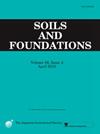Crack evolution mechanism of stratified rock mass under different strength ratios and soft layer thickness: Insights from DEM modeling
IF 3.3
2区 工程技术
Q2 ENGINEERING, GEOLOGICAL
引用次数: 0
Abstract
Research on stratified rock masses, which are common geological formations, has primarily focused on their mechanical properties, while studies on crack evolution and microscopic damage mechanisms remain limited. This study addresses this gap by investigating the combined effects of strength ratios and soft layer thicknesses on the microcrack evolution mechanism of stratified rocks using the discrete element method (DEM). Through FISH language programming in the particle flow code (PFC), this study reveals the acoustic emission (AE) characteristics, crack initiation and propagation, damage degree, and final failure characteristics. The key findings are: (1) Higher strength ratios between the hard and soft components of stratified rocks make specimens more sensitive to increases in soft layer thickness. (2) Three types of AE events were identified: continuous active, intermittent active, and silent. (3) Cracks initiate at the interface between components and propagate along the interface into the rock matrix. The strength ratios determine the crack propagation path and the damage extent of the components. (4) The failure of stratified rocks is primarily controlled by the soft component. Crack connections typically form vertical and sub-vertical tensile failure planes in the hard component, and a shear failure surface with a “V”-shaped intersection in the soft component.
不同强度比和软弱层厚度下分层岩体的裂缝演化机制:DEM 建模的启示
层状岩体是一种常见的地质构造,有关层状岩体的研究主要集中在其力学性能方面,而对裂缝演变和微观破坏机制的研究仍然有限。本研究利用离散元素法(DEM)研究了强度比和软层厚度对层状岩石微裂缝演化机制的综合影响,弥补了这一空白。通过在粒子流代码(PFC)中使用 FISH 语言编程,本研究揭示了声发射(AE)特征、裂纹起始和扩展、损伤程度以及最终破坏特征。主要发现有(1) 层状岩石软硬成分之间的强度比越高,试样对软层厚度的增加越敏感。(2) 确定了三种类型的 AE 事件:连续活动、间歇活动和无声。(3) 裂缝在成分之间的界面上产生,并沿着界面传播到岩石基质中。强度比决定了裂缝的传播路径和构件的破坏程度。(4) 分层岩石的破坏主要由软组分控制。裂缝连接通常在硬组分中形成垂直和次垂直的拉伸破坏面,在软组分中形成 "V "形交叉的剪切破坏面。
本文章由计算机程序翻译,如有差异,请以英文原文为准。
求助全文
约1分钟内获得全文
求助全文
来源期刊

Soils and Foundations
工程技术-地球科学综合
CiteScore
6.40
自引率
8.10%
发文量
99
审稿时长
5 months
期刊介绍:
Soils and Foundations is one of the leading journals in the field of soil mechanics and geotechnical engineering. It is the official journal of the Japanese Geotechnical Society (JGS)., The journal publishes a variety of original research paper, technical reports, technical notes, as well as the state-of-the-art reports upon invitation by the Editor, in the fields of soil and rock mechanics, geotechnical engineering, and environmental geotechnics. Since the publication of Volume 1, No.1 issue in June 1960, Soils and Foundations will celebrate the 60th anniversary in the year of 2020.
Soils and Foundations welcomes theoretical as well as practical work associated with the aforementioned field(s). Case studies that describe the original and interdisciplinary work applicable to geotechnical engineering are particularly encouraged. Discussions to each of the published articles are also welcomed in order to provide an avenue in which opinions of peers may be fed back or exchanged. In providing latest expertise on a specific topic, one issue out of six per year on average was allocated to include selected papers from the International Symposia which were held in Japan as well as overseas.
 求助内容:
求助内容: 应助结果提醒方式:
应助结果提醒方式:


